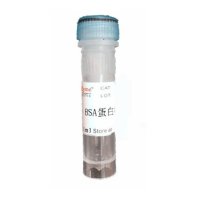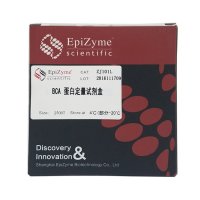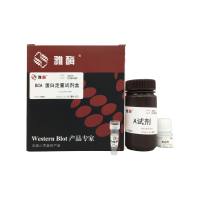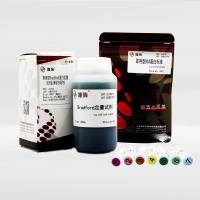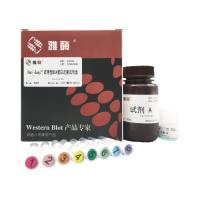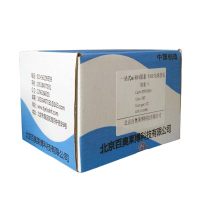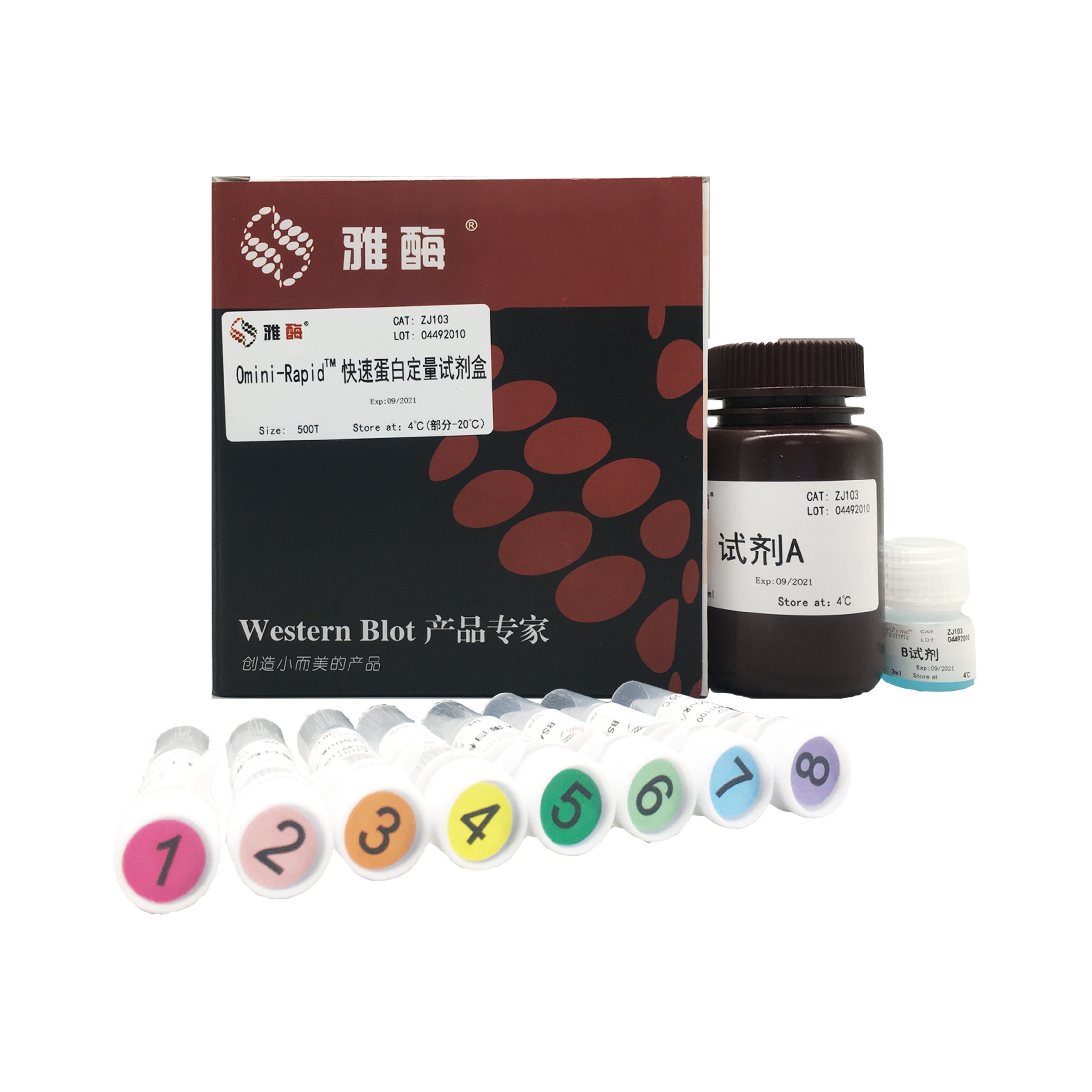
产品详情
文献和实验
相关推荐
规格 :500次(微孔)
Omni-Rapid™快速蛋白定量试剂盒
Omni-Rapid™Protein Assay Kit
本产品冰袋运输; 即用型BSA标准品 -20℃保存,其它组分4℃保存,保质期12个月。
货号规格
goodZJ103 500次(微孔)
产品内容
| 组分 | 体积 |
| 试剂A | 100 mL |
| 试剂B | 3 mL |
| 即用型BSA标准品①( 0 μg/mL ) | 1 mL |
| 即用型BSA标准品②(125 μg/mL) | 1 mL |
| 即用型BSA标准品③(250 μg/mL) | 1 mL |
| 即用型BSA标准品④(500 μg/mL) | 1 mL |
| 即用型BSA标准品⑤(750 μg/mL) | 1 mL |
| 即用型BSA标准品⑥(1000 μg/mL) | 1 mL |
| 即用型BSA标准品⑦(1500 μg/mL) | 1 mL |
| 即用型BSA标准品⑧(2000 μg/mL) | 1 mL |
产品特点
g
g
g
g
g
产品简介
goodOmni-Rapid™快速蛋白定量试剂盒的原理与传统BCA蛋白定量法类似,但采用了一种不同于BCA(Bicin-choninic Acid)的全新特殊的螯合剂,从而实现了对蛋白质浓度进行快速、稳定、灵敏的测定。其原理是在碱性环境下蛋白质分子中的肽键能与Cu2+形成络合物,将Cu2+还原成Cu+,Cu+与螯合物结合,从而发生颜色反应。本试剂盒中的螯合剂可敏感特异地与Cu+结合,只需室温孵育5 min即可形成稳定的橙黄色水溶性复合物,而传统BCA法则需在37℃下孵育30 min才可完成颜色反应。该橙黄色的复合物在480 nm处有强光吸收值,颜色的深浅与蛋白质浓度成正比,可根据吸收值的大小来测定蛋白质的含量。本试剂盒含有一系列浓度的蛋白质标准品溶液(BSA溶液),即取即用,无需稀释,方便快捷。
使用说明
good◈以微孔酶标仪法为例:
gooddd1. 配置显色工作液:
gooddd1. a. 计算显色工作液总量:
goodgoodgoodd工作液总量 = (BSA标准品样本个数+待测样本个数)×复孔数×每个样本显色工作液体积
gooddd1. a. 举例:BSA标准品样本个数为8个,待测样本个数3个,复孔数3个。
goodgoodgoodd显色工作液总量 = (8个BSA标准品样本+3个待测样本)×3个复孔×200 μL(每个样本工作液体积) = 6.6 mL
gooddd1. b. 根据计算出的显色工作液需要总量,将试剂A和试剂B按照50:1的体积比,配制显色工作液,充分混匀。
gooddd1. b. 注意:1) 试剂B刚加入试剂A时,会出现灰蓝色沉淀,但只需混匀几秒钟,沉淀就会消失,形成透亮的绿色溶液;
gooddd1. b. 注意:2)建议工作液现用现配,在室温下,工作液会逐渐变为深绿色,但只要在1.5 h内使用,对定量的准确性不会造成影响;
gooddd1. b. 注意:3) 由于加样可能存在误差,建议配制BCA工作液时,多配制1~2个孔。
gooddd2. 定量检测
gooddd3. (1)分别取 即用型BSA标准品①~⑧ 各20 μL加到96孔板中( BSA标准品 使用前须充分溶解摇匀);
| 孔号 | 1 | 2 | 3 | 4 | 5 | 6 | 7 | 8 |
| 添加物 | 标准品① | 标准品② | 标准品③ | 标准品④ | 标准品⑤ | 标准品⑥ | 标准品⑦ | 标准品⑧ |
| 体积(μL) | 20 | 20 | 20 | 20 | 20 | 20 | 20 | 20 |
| BSA终浓度(μg/mL) | 0 | 125 | 250 | 500 | 750 | 1000 | 1500 | 2000 |
gooddd3. (2)用1×PBS或0.9%生理盐水将样品适当稀释(可以多作几个梯度,如2倍、4倍、8倍稀释),加20 μL到96孔板的样品孔中;
gooddd3. (3)各孔加入200 μL显色工作液,充分混匀,盖上96孔板盖,室温孵育5min,即可进行检测;
gooddd3. (3)注意:由于颜色反应速度较快,须保证在20~30 min之内完成读值。如果必须在30 min后才能读值,可提前加入50 μL 1 M HCl终止反应。
gooddd3. (4)用酶标仪测定每个样品及BSA标准品的A480,注意要减去空白对照( 标准品① +工作液)的A480;
gooddd3. (5)绘制标准曲线,计算样品中的蛋白浓度。
gooddd3. (3)注意:数据处理时需要去除明显错误的值。待测样品浓度可以从标准曲线中查得, 实际浓度需要乘以样品的稀释倍数。如果是计算机绘制的曲线,可以从计算机给出的线性方程式计算出待测样品的浓度。
注意事项
good1. 本产品可以采用酶标仪(微孔检测法)或者分光光度计(试管检测法)测定蛋白浓度,如使用普通的分光光度计测定,需根据比色皿的最小检测体积,适当加大BCA工作液的用量使不小于最小检测体积,样品和标准品的用量可相应按比例放大也可不变。使用分光光度计测定蛋白浓度时,每个试剂盒可以测定的样品数量可能会显著减少;
good2. 建议每次测定蛋白样品时,都须绘制标准曲线,以获得准确数据;
good3. 完成室温孵育5 min后,须在20~30 min内完成检测,否则会影响蛋白定量的准确度;
good4. 如待测样品中含较多的干扰物质(具体见附表),可采用其它蛋白定量产品;
good5. 为了您的安全和健康,请穿实验服并戴一次性手套操作;
good6. 本产品仅限科研使用。
干扰物质附表
| 化合物 | 耐受浓度 | 化合物 | 耐受浓度 |
| 盐/缓冲液 | 去垢剂 | ||
| ACES, pH 7.8 | 25mM | Brij-35 | 5.0% |
| Bicine, pH 8.4 | 20mM | Brij-58 | 1.0% |
| Borate | 50mM | Na Deoxycholate(DOC) | 5.0% |
| Calcium chloride in TBS, pH 7.2 | 10mM | Octyl β-glucoside | 5.0% |
| Na-Carbonate/Na-Bicarbonate, pH 9.4 | 0.1M | Span-20 | 0.5% |
| Cesium bicarbonate | 100mM | TritonX-100 | 5.0% |
| CHES, pH 9.0 | 100mM | Triton-X-114, riton-X-305,Triton-X-405 | 1.0% |
| Na-Citrate | 75mM | Tween-20, Tween-60, Tween-80 | 5.0% |
| MOPS, pH 7.2 | 100mM | CHAPS | 5.0% |
| Cobalt chloride in TBS, pH 7.2 | 0.8mM | CHAPSO | 5.0% |
| EPPS, pH 8.0 | 100mM | Zwittergent 3-14 | 1.0% |
| Ferric chloride in TBS, pH 7.2 | 10mM | 螯合剂 | |
| Glycine•HCl, pH 2.8 | 100mM | EDTA | 10mM |
| Ammonium sulfate | Ø | Sodium citrate | 200mM |
| Guanidine•HCl | 4M | 还原剂 | |
| HEPES, pH 7.5 | 100mM | 2-mercaptoethanol | Ø |
| Imidazole, pH 7.0 | 12.5mM | Dithiothreitol (DTT) | Ø |
| MES, pH 6.1 | 100mM | N-acetylglucosamine in PBS, pH 7.2 | 10mM |
| MES (0.1M), NaCl (0.9%), pH 4.7 | Undiluted | 糖类 | |
| Nickel chloride in TBS, pH 7.2 | 10mM | Glucose | 10mM |
| PBS; Phosphate (0.1 M), NaCl (0.15 M), pH 7.2 | Undiluted | 其它 | |
| A-cetone | 10% | ||
| PIPES, pH 6.8 | 100mM | Acetonitrile | 10% |
| RIPA lysis buffer: 50 mM Tris, 150 mM NaCl, 0.5% DOC, 1% NP-40, 0.1% SDS, pH 8.0 |
Undiluted | Aprotinin | 10mg/L |
| DMF | 10% | ||
| DMSO | 10% | ||
| Sodium acetate, pH 4.8 | 200 mM | Ethanol | 10% |
| Sodium azide | 0.2% | Glycerol (fresh) | 10% |
| Sodium bicarbonate | 100mM | Hydrochloric acid | 100mM |
| Sodium chloride | 1 M | Leupeptin | 10mg/L |
| Sodium citrate, pH 4.8 or pH 6.4 | 200mM | Methanol | 10% |
| Sodium phosphate | 100mM | N/A | |
| Tricine, pH 8.0 | 25mM | ||
| Triethanolamine, pH 7.8 | 25mM | ||
| Tris | 250mM | ||
| TBS: Tris (25 mM), NaCl (0.15 M), pH 7.6 | Undiluted | ||
| Tris (25 mM), Glycine (192 mM), pH 8.0 | 1:2 dilution | ||
相关论文
good1. Cheng, B., Zhang, H., Hu, J., Peng, Y., Yang, J., Liao, X., ... & Lu, H. (2020). The immunotoxicity and neurobehavioral toxicity of zebrafish induced by famoxadone-cymoxanil. Chemosphere, 247, 125870. (IF 7.086)
good2. WANG, Feng, et al. Adrenomedullin 2 improves bone regeneration in type 1 diabetic rats by restoring imbalanced macrophage polarization and impaired osteogenesis. Stem cell research & therapy, 2021, 12.1: 1-15.(IF 6.832)
good3. XIAO, Lili, et al. Molecular Behavior of HMGB1 in the Cochlea Following Noise Exposure and in vitro. Frontiers in Cell and Developmental Biology, 2021, 9: 350.(IF 6.684)
good4. WANG, Feng, et al. Accelerated Bone Regeneration by Astragaloside IV through Stimulating the Coupling of Osteogenesis and Angiogenesis. International Journal of Biological Sciences, 2021, 17.7: 1821.(IF 6.58)
good5. JIANG, Qian, et al. 4-Phenylbutyric acid accelerates rehabilitation of barrier function in intestinal porcine epithelial cell (IPEC-J2) monolayer model. Animal Nutrition, 2021.(IF 6.383)
good6. LIU, Chang, et al. Value of Pyruvate Carboxylase in Thyroid Fine-Needle Aspiration Wash-Out Fluid for Predicting Papillary Thyroid Cancer Lymph Node Metastasis. Frontiers in oncology, 2021, 11: 1625.(IF 6.244)
good7. LIU, Heze, et al. Prenatal dexamethasone exposure induces nonalcoholic fatty liver disease in male rat offspring via the miR-122/YY1/ACE2-MAS1 pathway. Biochemical Pharmacology, 2021, 185: 114420.(IF 5.858)
good8. PIAO, Jinmei, et al. Effects of real-ambient PM2. 5 exposure on lung damage modulated by Nrf2. Frontiers in pharmacology, 2021, 12: 913.(IF 5.810)
good9. ZHANG, Junqian, et al. Andrographolide Induces Noxa-Dependent Apoptosis by Transactivating ATF4 in Human Lung Adenocarcinoma Cells. Frontiers in pharmacology, 2021, 12: 924.(IF 5.810)
good10. Feng, F., Cheng, P., Xu, S., Li, N., Wang, H., Zhang, Y., & Wang, W. (2020). Tanshinone IIA attenuates silica-induced pulmonary fibrosis via Nrf2-mediated inhibition of EMT and TGF-β1/Smad signaling. Chemico-Biological Interactions, 109024.(IF 5.192)
good11. SU, Juanjuan, et al. Identification and Biochemical Characterization of a Surfactant-Tolerant Chondroitinase VhChlABC from Vibrio hyugaensis LWW-1. Marine Drugs, 2021, 19.7: 399.(IF 5.118)
good12. SONG, Lin; PENG, Juan; GUO, Xuejun. Exosomal lncRNA TCONS_00064356 derived from injured alveolar epithelial type II cells affects the biological characteristics of mesenchymal stem cells. Life Sciences, 2021, 278: 119568.(IF 5.037)
good13. ZHOU, Yixi, et al. Chronic exposure to environmentally realistic levels of diuron impacts the behaviour of adult marine medaka (Oryzias melastigma). Aquatic Toxicology, 2021, 105917.(IF 4.964)
good14. Zhao, Y., Tao, M., Wang, R., Guo, Y., & Wang, M. (2020). Japonicone V, a sesquiterpene lactone derivative from the flowers of Inula japonica, inhibits hepatitis E virus replication by targeting virus-associated autophagy. Journal of Functional Foods, 65, 103755.(IF 4.451)
good15. He, S., Chen, M., Lin, X., Lv, Z., Liang, R., & Huang, L. (2020). Triptolide inhibits PDGF-induced proliferation of ASMCs through G0/G1 cell cycle arrest and suppression of the AKT/NF-κB/cyclinD1 signaling pathway. European Journal of Pharmacology, 867, 172811.(IF 4.432)
good16. Kang, L., Miao, J. X., Cao, L. H., Miao, Y. Y., Liu, H., Xiang, L., & Song, Y. G. (2020). Total glucosides of herbaceous peony (Paeonia lactiflora Pall.) flower attenuate adenine-and ethambutol-induced hyperuricaemia in rats. Journal of Ethnopharmacology, 113054.(IF 4.360)
good17. HE, Zhidong, et al. The role of MEG3 in the proliferation of palatal mesenchymal cells is related to the TGFβ/Smad pathway in TCDD inducing cleft palate. Toxicology and Applied Pharmacology, 2021, 419: 115517.(IF 4.219)
good18. Su, J., Yu, B., Zhang, C., Yi, P., Li, H., Xu, C., ... & Chen, J. (2020). Long noncoding RNA HOXC-AS3 indicates a poor prognosis and regulates tumorigenesis by binding to YBX1 in breast cancer. American journal of translational research, 12(10), 6335. (IF 4.060)
good19. LANG, Jiangli, et al. High glucose activates ERK1/2 to stabilize AP1 and increase MMP9 expression in diabetic foot ulcers. Experimental Cell Research, 2021, 403.1: 112550.(IF 3.905)
good20. Yang, Y., Yang, X., Lin, Y., Yang, G., & Li, L. (2020). LASS2 regulates hepatocyte steatosis by interacting with NDUFS2/OXPHOS related proteins. Biochemical and Biophysical Research Communications. (IF 3.575)
good2. WANG, Feng, et al. Adrenomedullin 2 improves bone regeneration in type 1 diabetic rats by restoring imbalanced macrophage polarization and impaired osteogenesis. Stem cell research & therapy, 2021, 12.1: 1-15.(IF 6.832)
good3. XIAO, Lili, et al. Molecular Behavior of HMGB1 in the Cochlea Following Noise Exposure and in vitro. Frontiers in Cell and Developmental Biology, 2021, 9: 350.(IF 6.684)
good4. WANG, Feng, et al. Accelerated Bone Regeneration by Astragaloside IV through Stimulating the Coupling of Osteogenesis and Angiogenesis. International Journal of Biological Sciences, 2021, 17.7: 1821.(IF 6.58)
good5. JIANG, Qian, et al. 4-Phenylbutyric acid accelerates rehabilitation of barrier function in intestinal porcine epithelial cell (IPEC-J2) monolayer model. Animal Nutrition, 2021.(IF 6.383)
good6. LIU, Chang, et al. Value of Pyruvate Carboxylase in Thyroid Fine-Needle Aspiration Wash-Out Fluid for Predicting Papillary Thyroid Cancer Lymph Node Metastasis. Frontiers in oncology, 2021, 11: 1625.(IF 6.244)
good7. LIU, Heze, et al. Prenatal dexamethasone exposure induces nonalcoholic fatty liver disease in male rat offspring via the miR-122/YY1/ACE2-MAS1 pathway. Biochemical Pharmacology, 2021, 185: 114420.(IF 5.858)
good8. PIAO, Jinmei, et al. Effects of real-ambient PM2. 5 exposure on lung damage modulated by Nrf2. Frontiers in pharmacology, 2021, 12: 913.(IF 5.810)
good9. ZHANG, Junqian, et al. Andrographolide Induces Noxa-Dependent Apoptosis by Transactivating ATF4 in Human Lung Adenocarcinoma Cells. Frontiers in pharmacology, 2021, 12: 924.(IF 5.810)
good10. Feng, F., Cheng, P., Xu, S., Li, N., Wang, H., Zhang, Y., & Wang, W. (2020). Tanshinone IIA attenuates silica-induced pulmonary fibrosis via Nrf2-mediated inhibition of EMT and TGF-β1/Smad signaling. Chemico-Biological Interactions, 109024.(IF 5.192)
good11. SU, Juanjuan, et al. Identification and Biochemical Characterization of a Surfactant-Tolerant Chondroitinase VhChlABC from Vibrio hyugaensis LWW-1. Marine Drugs, 2021, 19.7: 399.(IF 5.118)
good12. SONG, Lin; PENG, Juan; GUO, Xuejun. Exosomal lncRNA TCONS_00064356 derived from injured alveolar epithelial type II cells affects the biological characteristics of mesenchymal stem cells. Life Sciences, 2021, 278: 119568.(IF 5.037)
good13. ZHOU, Yixi, et al. Chronic exposure to environmentally realistic levels of diuron impacts the behaviour of adult marine medaka (Oryzias melastigma). Aquatic Toxicology, 2021, 105917.(IF 4.964)
good14. Zhao, Y., Tao, M., Wang, R., Guo, Y., & Wang, M. (2020). Japonicone V, a sesquiterpene lactone derivative from the flowers of Inula japonica, inhibits hepatitis E virus replication by targeting virus-associated autophagy. Journal of Functional Foods, 65, 103755.(IF 4.451)
good15. He, S., Chen, M., Lin, X., Lv, Z., Liang, R., & Huang, L. (2020). Triptolide inhibits PDGF-induced proliferation of ASMCs through G0/G1 cell cycle arrest and suppression of the AKT/NF-κB/cyclinD1 signaling pathway. European Journal of Pharmacology, 867, 172811.(IF 4.432)
good16. Kang, L., Miao, J. X., Cao, L. H., Miao, Y. Y., Liu, H., Xiang, L., & Song, Y. G. (2020). Total glucosides of herbaceous peony (Paeonia lactiflora Pall.) flower attenuate adenine-and ethambutol-induced hyperuricaemia in rats. Journal of Ethnopharmacology, 113054.(IF 4.360)
good17. HE, Zhidong, et al. The role of MEG3 in the proliferation of palatal mesenchymal cells is related to the TGFβ/Smad pathway in TCDD inducing cleft palate. Toxicology and Applied Pharmacology, 2021, 419: 115517.(IF 4.219)
good18. Su, J., Yu, B., Zhang, C., Yi, P., Li, H., Xu, C., ... & Chen, J. (2020). Long noncoding RNA HOXC-AS3 indicates a poor prognosis and regulates tumorigenesis by binding to YBX1 in breast cancer. American journal of translational research, 12(10), 6335. (IF 4.060)
good19. LANG, Jiangli, et al. High glucose activates ERK1/2 to stabilize AP1 and increase MMP9 expression in diabetic foot ulcers. Experimental Cell Research, 2021, 403.1: 112550.(IF 3.905)
good20. Yang, Y., Yang, X., Lin, Y., Yang, G., & Li, L. (2020). LASS2 regulates hepatocyte steatosis by interacting with NDUFS2/OXPHOS related proteins. Biochemical and Biophysical Research Communications. (IF 3.575)

上海雅酶生物医药科技有限公司
品牌商实名认证
钻石会员
入驻年限:7年

